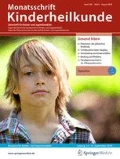Zusammenfassung
Rechtzeitig begonnene und couragiert durchgeführte Ersthelfermaßnahmen bei kindlichen Atem- und Kreislaufstillständen können zu einer erheblichen Verbesserung der Mortalität und Morbidität führen. Nach Überprüfung der Vitalfunktionen (Bewusstsein, Atmung, Kreislauf) werden zunächst die Atemwege frei gemacht und mit 5 initialen Beatmungen begonnen. Eine suffiziente Herzdruckmassage ist für die kardiopulmonale Reanimation des Kindes essenziell (15-mal Herzdruckmassage:2-mal Beatmung). Diese einfachen Basismaßnahmen der Reanimation sollten von jedem beherrscht und ohne Verzögerung begonnen werden, um die Sauerstoffversorgung von Herz und Gehirn bis zum Eintreffen professioneller Hilfe zu gewährleisten. Die erweiterten Reanimationsmaßnahmen beinhalten die Gabe von Medikamenten, Herzrhythmusanalyse und ggf. eine Defibrillation. Reanimationssituationen sind in der Pädiatrie insgesamt selten und stellen für alle Beteiligten eine hohe kognitive Herausforderung und eine große emotionale Belastung dar. Daher sind ständige Schulungsmaßnahmen zum Erlernen und zur Auffrischung der BLS- („basic life support“) und ALS-Maßnahmen („advanced life support“) erforderlich. Hierfür werden spezielle Kinderreanimationskurse (European Paediatric Life Support, EPLS) des European Resuscitation Council (www.erc.edu) angeboten. Außerdem finden teamorientierte Ausbildungskonzepte an hochmodernen Patientensimulatoren zunehmende Verbreitung (z. B. www.paedsim.org).
Abstract
Timely and high-quality basic life support leads to a reduction of morbidity and mortality in cases of paediatric cardiac arrest. After assessing consciousness, breathing and circulation, the airway should be opened and secured and in the case of insufficient breathing five rescue breaths should be given. Effective chest compressions are a critical component of resuscitation and should be performed in conjunction with assisted ventilation in a compression to ventilation ratio of 15:2 in a patient without a secure airway. All paediatric care providers should master life-saving skills. When a clear indication exists, basic life support should be started immediately and continued until professional help arrives in order to prevent further hypoxia and maintain cerebral perfusion. Advanced paediatric life support consists of medications, rhythm analysis and defibrillation. Resuscitations in children are rare events and represent a high cognitive load and a significant emotional challenge. Therefore, recurrent training in paediatric basic and advanced life support is essential. European Paediatric Life Support courses (EPLS) are offered by the European Resuscitation Council (www.erc.edu) and simulation-based team-oriented approaches to training paediatric resuscitations are increasing in popularity (www.paedsim.org).









Literatur
Biarent D, Bingham R, Eich C (2010) Lebensrettende Maßnahmen bei Kindern („paediatric life support“). Notfall Rettungsmed 13:635–664
European Resuscitation Council (2010) Guidelines for resuscitation. Section 6. Paediatric life support. Resuscitation 81:1364–1388
Gausche M, Lewis RJ, Stratton et al (2000) Effect of out-of-hospital pediatric endotracheal intubation on survival and neurologic outcome. JAMA 283:783–790
Heinzel O, Eppich WJ, Schwindt JC, Hoffmann F (2011) Der lebensbedrohliche Kindernotfall im Notarztdienst. Notfall Rettungsmed 14:151–165
Interessenkonflikt
Der korrespondierende Autor gibt an, dass kein Interessenkonflikt besteht.
Author information
Authors and Affiliations
Consortia
Corresponding author
Additional information
Der Originaltext der Leitlinien wurde im Dezember in deutscher Sprache in der Zeitschrift Notfall + Rettungsmedizin veröffentlicht (Notfall Rettungsmed 2010; 13:635–664).
Rights and permissions
About this article
Cite this article
Hoffmann, F., Heimberg, E., Schwindt, JC. et al. Kardiopulmonale Reanimation bei Kindern und Jugendlichen. Monatsschr Kinderheilkd 159, 479–487 (2011). https://doi.org/10.1007/s00112-010-2346-6
Published:
Issue Date:
DOI: https://doi.org/10.1007/s00112-010-2346-6
Schlüsselwörter
- Reanimation
- Basismaßnahmen der Reanimation
- Erweiterte Reanimation
- Reanimationsempfehlungen 2010
- EPLS-Leitlinien 2010

